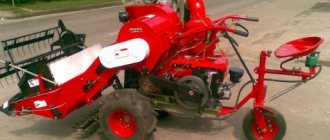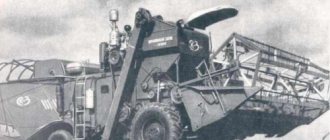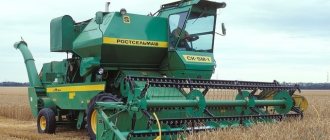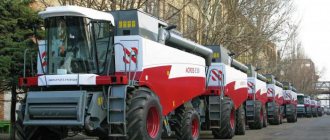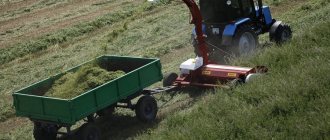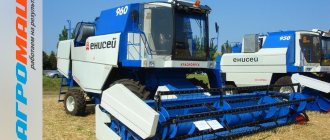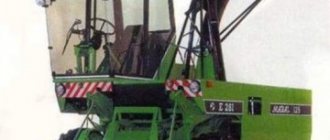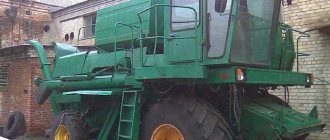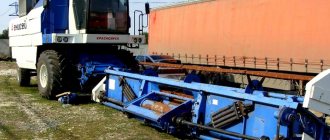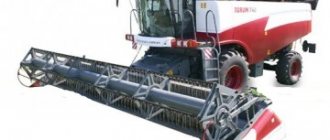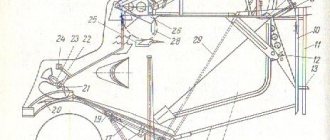Niva SK 5 is a self-propelled grain harvester of medium productivity, produced in the Soviet years by the Rostselmash enterprise. In the 1970-1980s, the model was considered the leader in the combine harvester market and the standard of agricultural engineering in the USSR. Equipment was exported to 50 countries. Later, the model was replaced by more modern combines of the Akros family.
Niva SK 5 is a legend of domestic mechanical engineering. The combine appeared in the mid-1970s and soon became very popular. The release of a deeply modernized variation of the Niva SK 5 continues to this day. Updated versions of the combine can compete with foreign analogues. Niva SK 5 is used in small and medium-sized farms with small cultivation areas, for which the use of high-performance equipment is impractical. In such conditions, the model remains extremely effective, which is why the demand for it continues.
Video
The history of the model began in 1958. Then the Rostselmash plant presented 27 of the latest SK 3 self-propelled combines, created from scratch (the numbers in the name had the following interpretation: SK - self-propelled combine, 3 - productivity, kg/sec). Previously, the company produced exclusively trailed versions, so the emergence of fundamentally new equipment was of great importance. In the winter of 1962, the SK 4 model with increased productivity was introduced. Another 11 years later, the premiere of the last representative of the family, the Niva SK 5 combine, took place. The equipment appeared as a result of a deep modernization of the previous version. Subsequently, the model was updated several times. Currently, the combine is sold under the name SK 5 Niva-Effect. The equipment now has a cabin with air conditioning, and green is used instead of the traditional red color. The popularity of the car remains high; it can still be found on Russian fields.
News here.
The main field of activity of the combine is the collection and primary processing of grain crops. Maneuverability and compact dimensions allow the equipment to work effectively in difficult terrain and narrow areas. The small turning radius makes the machine ideal for small areas. In cramped conditions, the Niva SK 5 simply has no equal.
Rostselmash also produces a special version designed for wet and weak-bearing soil. The modification is equipped with a half-track. Such changes make it possible to work in rice fields.
Together with special equipment, the combine can harvest corn. Improvements to the header provide the ability to work with soybeans, buckwheat and other cereal crops.
Niva SK 5 remains one of the most reliable and widespread combine harvesters in Russia.
Header of combine Niva SK-5
Any combine harvester contains five main parts: the header, the thresher, the stacker, the chassis and the engine. In addition, the combine is equipped with a hydraulic system, drive mechanisms, controls and alarms. SK 5 “Niva” is an example of a timeless classic scheme of a combine harvester, which has a supporting thresher and mounted header and stacker.
The header mows down the grain mass and transports it to the combine thresher. It includes a housing, a reel, a cutting device, an auger and drive and adjustment mechanisms. The header body is hingedly mounted on an inclined chamber on a central hinge and suspensions.
The length-adjustable suspension serves to avoid distortions of the header relative to the thresher. The basis of the header is a welded body. On the back there are removable supports that can take a working or transport position. The working position of the supports is used during installation, repair and storage. At the bottom of the body there are copying shoes, which serve as the front support of the header in the case of the direct method of harvesting from the copier. relief of the field. The shoes can take any of 4 positions. thereby adjusting the cutting height of the stems.
Share
Specifications
Dimensions:
- length – 7607 mm;
- width – 3930 mm;
- height – 4100 mm.
The mass of the combine is 7400 kg.
Performance characteristics:
- productivity – 5 kg/sec;
- threshing drum rotation speed – 2900 rpm;
- header width – 5000 mm;
- Hopper volume – 3000 l;
- bunker unloading speed – 40 l/sec;
- height of unloading from the bunker – 2900 mm.
Other parameters:
- length of straw walker elements – 3600 mm;
- number of straw walker elements – 4;
- diameter of the threshing apparatus – 600 mm;
- drum rotation frequency – 2900 rpm.
Engine
The latest versions of Niva SK 5 are equipped with 4-stroke in-line diesel units of the MMZ D.260.1 model (manufacturer: Minsk Motor Plant). This engine is ideal for a variety of tasks thanks to its large torque reserve, providing excellent traction when driving on difficult terrain or under full load.
The unit is liquid cooled. Among the advantages of the MMZ D.260.1 engine, moderate fuel consumption and smooth operation should be highlighted. The average fuel consumption for the Niva SK 5 combine harvester with this engine is 25 l/hour. Depending on the nature of the work, the indicator may vary. The unit is located behind the grain bin.
Characteristics of the MMZ D.260.1 motor:
- working volume – 7.12 l;
- rated power – 114 (155) kW (hp);
- maximum torque – 622 Nm;
- rotation speed – 2100 rpm;
- number of cylinders – 6;
- cylinder diameter – 110 mm;
- compression ratio – 16.
Also, the Niva SK 5 model was equipped with the following types of engines:
- diesel units SMD-17K (SMD-18K) with a power of 100 hp;
- diesel engines SMD-19K (SMD-20K) with a power of 120 hp;
- gasoline power plants (the first modifications of the combine).
Design and service features
The chassis of the Niva SK 5 series consists of a drive and steering axle. The first includes a clutch, 2 final drives, a gearbox, a special brake and wheels. The clutch is located on the receiving pulley of the transmission drive shaft. There are 2 carriages on the drive shaft (the first includes reverse and 1st gears, the second – 2nd and 3rd gears). When the gear is engaged, the gears are locked by a special locking mechanism. The steering wheel bridge is made in the form of a rigid beam with steering knuckles, wheels and a trapezoid with a hydraulic cylinder. Wheel axle shafts are installed at the ends of the beam using pins and hinges.
Niva SK 5 has a V-belt variator, therefore the force from the motor pulley to the transmission pulley is transmitted using a V-belt drive. The variator is used to change the gear ratio. The transmission is controlled from the cab by moving the hydraulic valve spool handle. When placed in the rear position, the minimum speed is selected, in the forward position, the maximum speed is selected.
The main working part of the Niva SK 5 combine is the header, which is used for mowing and moving grain to the thresher. Additionally, it can be equipped with a picker that collects mown stems. The header on this model consists of the following elements:
- body with shoes. The main working mechanisms of the header are attached to it. The body itself is suspended using a spherical hinge and hangers from the inclined chamber;
- a reel that brings and supports the stems during the cutting process and sends them to the auger. The element is based on a shaft with crosspieces attached to it. They are joined by rakes, which are a tubular structure with spring-loaded fingers;
- cutting apparatus. Used for cutting stems during the harvesting process. The cutting apparatus includes friction plates, a finger bar with counter-cutting knife plates and single fingers, a drive mechanism and pressure blades. The system operates from an articulated telescopic transmission mounted on the header body;
- an auger that narrows and feeds the flow of stems to the conveyor. The element consists of a cylinder with spiral strips welded to it, in right and left directions, shifting the collected stems to the middle;
- floating conveyor accompanying the grain mass into the thresher. It is located in an inclined housing and consists of drive and driven shafts with sprockets and roller-bushing chains;
- a pick-up that selects cut crops from windrows and delivers them to the header platform. To install it, you must remove the reel. The pick-up is used for separate combining.
The hydraulic system of the equipment includes 2 hydraulic systems: steering and main. The latter includes safety valves, a 2-way hydraulic cylinder of the chassis variator, hydraulic cylinders for lifting the reel and header, an NSh-32U hydraulic pump and a hydraulic distributor with 7 outputs. The main hydraulic system serves the working mechanisms. The steering hydraulic system includes a hydraulic distributor, a power cylinder, an NSh-10E pump and a metering pump. Both systems are connected to one 14 liter hydraulic tank.
In the first modifications of the Niva SK 5, the cabins had “Spartan” working conditions. The only advantage was the presence of forced ventilation, which still did not save us from the intense heat. The steering column was located near the operator. Separate brake pedals and a hay unloading pedal were located to the right of the gear shift lever, and the parking brake and clutch were located to the left. Next to the driver's seat there were switches and control levers for the equipment system (unloading of the bunker, reaper, thresher and other mechanisms). In the latest variations, conditions have improved significantly. A sprung chair appeared with adjustments in the horizontal and vertical planes and weight adjustment. Sound insulation and upholstery became much better, and air conditioning was optionally installed.
Niva SK 5 is considered one of the most reliable combine harvesters. However, this technique also requires maintenance. To maintain easy control, it is necessary to regularly change the oil in the hydraulic drive (about once every 20 days during intensive work). Shoes are usually removed on wet or loose ground to prevent the pad from packing up and preventing normal movement.
Excessively high speed of the pick-up in comparison with the speed of the equipment (more than 30%) can lead to rupture of the rolls and loss of grain. Often the straw walker of the Niva SK 5 model gets clogged. In this case, a corresponding signal will appear on the control panel; the operator should reduce the driving speed. It is also necessary to regularly change drive belts, which wear out quite quickly.
Niva SK 5 is a simple and effective assistant, which is a leader in the segment of budget combines.
Design of the Niva SK-5 combine
1. Reel 2. Cutting device 3. Auger 4. Finger device 5. Feeder 6. Receiving beater 7. Stone catcher 8. Drum 9. Deck attachment 10. Main deck 11. Breaker beater 12. Straw walker 13. Transport (shaking) board 14. Finger (leveling) screen 15. Upper sieve 16. Upper sieve extension 17. Lower sieve 18. Sloping board 19. Grain auger 20. Ear auger 21. Grain elevator 22. Elevator 23. Upper (distribution) grain auger 24. Extension ramp 25. Half filler 26 Chopping drum with knives 27 Shear bar 28. Chopper auger 29. Chopper fan 30. Hopper 31. Cleaning fan.
Principle of operation
The reel, rotating, tilts the stems, the cutting device cuts them, and the reel is placed on a narrowing auger. The auger narrows the mass and feeds it into the feeder chamber using a finger apparatus; the feeder chamber's floating conveyor feeds it into the threshing and separating device (MSD).
The receiving beater picks up the mass and delivers it to the drum. The falling stones are knocked off by the receiving beater blades into the stone catcher. The chamber of the stone catcher is filled with loose mass, so the cut plants slide along it and are directed by the receiving beater blades into the gap between the drum and the deck, and the stones break through this cushion and fall to the bottom of the stone catcher. The drum with its whips drags the mass along the deck. The whips, striking the ears, knock out the grain, which falls into the holes of the deck. In order to injure the grain less, notches are made on the whips - reefs; they replace a direct blow with a sliding one. With such an impact, the grain is less damaged. Because reefs shift the mass to the side, overloading one side of the harvester and underloading the other. To prevent this from happening, the whips are placed alternately with left and right notches (reefs). Since the drum rotates at high speed (about 1000 rpm for wheat), it accelerates the mass on the deck, the speed of the mass increases, and its thickness decreases. For high-quality threshing, constant contact between the whip, the ear and the deck is necessary, so the gap at the exit from the MSU is reduced (for wheat, the entrance is 18 mm, the middle is 14 mm, the exit is 2 mm). The ears, passing along the deck, hit the transverse bar and release the grain, thus, 100% of the grain is threshed in the MSU, and about 80% is separated from the straw. The remaining 20% of free grain, along with straw and torn off spikelets, goes to the straw walker. The grain, spikelets and chaff that have passed through the deck go to the transport cleaning board. The beater beats the straw from the drum and directs it to the beginning of the straw walker.
Straw, free grain and spikelets that fall on the straw walker are fluffed up and transported back to the stacker due to the stepped surface and circular movements of the keys. Since the mass fluffs up, heavier spikelets (than straw) and grain fall down, pass through the louvered openings of the keys and slide along the inclined bottom of the keys onto the cleaning conveyor board, and the straw goes into the stacker.
The grain heap (grain, chaff, spikelets and small debris) arrives at the shaking board from the MSU and the straw walker. Due to the stepped surface and the reciprocating movements of the shaking board, the heap moves back to the finger grid. Small particles (grain, chaff and small spikelets) fall through the finger grid and fall to the beginning of the upper sieve, and large particles leave the finger grid and fall to the middle of the upper sieve. The upper sieve consists of blinds, they are 2/3 open. All the grain and small spikelets fall through them, and large spikelets go to the extension of the upper sieve, the chaff is blown by a fan into the stacker, the spikelets that fall on the extension fall through its blinds and fall into the grain auger. All grain and small spikelets that fall on the lower sieve are transported back due to the stepped surface (blinds) and circular movements. Since the blinds are 1/3 open, only the grain falls through them and falls onto the slope board, while the spikelets come off and fall into the grain auger. The grain rolls down the ramp and enters the grain auger. Spikelets from the grain auger fall into the grain elevator, then onto the upper grain auger (distribution). From it to the breaker beater, then to the drum, for repeated threshing. The grain is fed by a grain auger to the grain elevator into the bunker. The straw that gets into the stacker is compacted by the floor filler using a pre-pressing chamber. The entrance to the chamber is wide, and the exit is narrow, so the straw is compressed 2 times. The chaff filler directs the chaff to the bottom of the stacker. When the stacker is full and the combine approaches a row of haystacks, the combiner presses the pedal and the haystack is unloaded. After the stack has cleared, the stacker closes automatically.
Currently, most combine harvesters are equipped with a chopper instead of a stacker. In the pulper, the straw is crushed and, together with the chaff, is scattered across the field, or loaded into a vehicle.
Price
The latest generation of the Niva SK 5 combine in the stock version is offered for 1.3-1.6 million rubles.
This model is represented very widely on the secondary market, and the cost starts from 100 thousand rubles. Fresh versions (later than 2006) in good condition will cost from 500 thousand rubles. When purchasing used equipment, you should inspect the frame and other structural elements for rust. Among the mechanisms, it is necessary to check the condition of the thresher, concave, engine and drum.
Purchase of combine harvesters for farming
You can purchase a combine harvester for a farm based on recommendations from friends. But these are not all search methods. In modern media there are rubricators, which necessarily have a section dedicated to agricultural machinery. This is where you should start searching for information about the availability of the right type of agricultural machinery for your own needs.
The Internet is increasingly acting as a platform for searching for information. The table below shows the effectiveness of different media in searching and purchasing different types of equipment, including equipment for rural areas. Data provided by MASMI in 2015.
| Type of media | Viewing information by the population, % | Purchase through advertising, % |
| Newspapers | 3…4 | 2…4 |
| Magazines | 5…8 | 2…5 |
| Internet | 1…1,5 | 0,5…0,8 |
| A television | 5…9 | 3…5 |
| Radio | 0,5…1 | 0,3…0,4 |
As can be seen from the table above, population activity is relatively low. The Internet is just gaining its users. Television is the most effective.
Having a mobile connection allows you to contact the seller as soon as possible. If you find an advertisement with information of interest, you can ask to make a short film that will demonstrate the performance of the product. It’s not difficult to shoot a short video on your smartphone. Even in rural areas, there are always people who can assist the seller in filming a video and sending it to the buyer.

